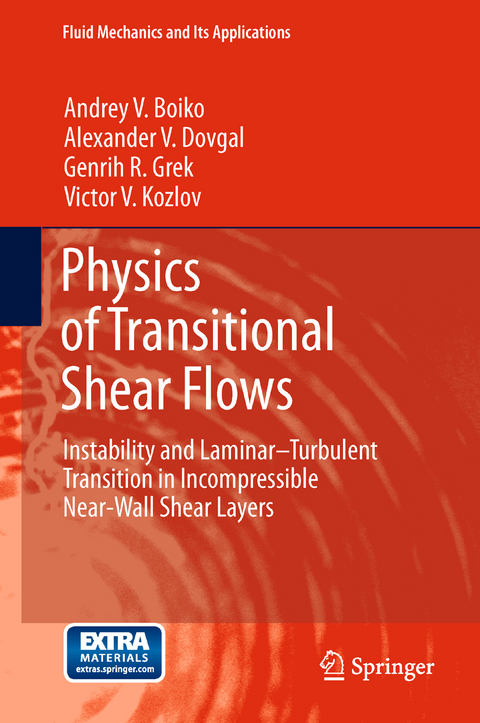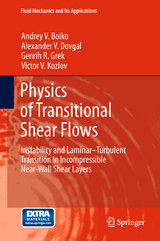Physics of Transitional Shear Flows
To access the supplementary material go to extras.springer.com and type in the ISBN for this volume.
Part I Fundamentals of the linear stability theory : 1 Concept of hydrodynamic stability.- 1.1 Hydrodynamic stability .- 1.2 Stability of fluid motion in time .- 1.2.1 Critical parameters for onset of instability .- 1.2.2 Conditional stability .- 1.2.3 Growth of disturbance energy .- References .- Further Reading .- 2 Theoretical aspects : 2.1 Formulation of linear hydrodynamic stability problems .- 2.1.1 Spectral formulation of stability .- 2.1.2 Inviscid instability mechanism .- 2.1.3 Viscous instability mechanism .- 2.2 Instability in space .- 2.3 Gaster’s transformation .- 2.4 Squire theorem .- 2.5 Adjoint problem and bi-orthogonality of normal modes .- 2.6 Completeness of solutions for the Orr–Sommerfeld and Squire equations.- References .- Further Reading .- Part II Generic problems : 3 Instability of plane parallel flows : 3.1 Plane Couette flow .- 3.2 Plane Poiseuille flow .- 3.2.1 Numerical results .- 3.2.2 Experimental linear stability investigations .- 3.3 Method of linear stability calculations .- Exercises.- References .- Further Reading .- 4 Instability of the flat-plate boundary layer : 4.1 Historical notes .- 4.2 Solution of the Orr–Sommerfeld equation for the boundary layers .- 4.3 Nonparallel flow effects .- 4.3.1 Outline of theoretical approaches to account for nonparallel effects .- 4.3.2 Modern view on the place and role of nonparallel effects in the Blasius boundary layer .- Exercises .- References .- Further Reading .- 5 Instabilities of plane flows over curvilinear surfaces: 5.1 Influence of curvature on the basic flow .- 5.1.1 Equations of motion in cylindrical coordinates .- 5.1.2 Description of the flow in boundary layers over curvilinear surfaces .- 5.2 Hydrodynamic instability at curvilinear surfaces .- 5.2.1 Taylor problem .- 5.2.2 Dean problem .- 5.2.3 G¨ortler problem .- Exercises .- References .- Further Reading .- 6 Some other basic factors of shear-layer stability: 6.1 Axial flowsymmetry .- 6.2 Two-dimensional geometry .- 6.3 Transverse flow periodicity .- 6.4 Pressure gradients .- 6.4.1 Streamwise pressure gradient .- 6.4.2 Transverse pressure gradient .- 6.5 Heat transfer .- 6.6 Fluid suction .- 6.7 Compliant boundaries .- 6.8 Dusty flow .- Exercises .- References .- Further Reading .- 7 Instability of separated boundary layers.- 7.1 Basic features of separated flow instability .- 7.2 Linear instability at flow separation in plane configurations .- 7.2.1 Waveform .- 7.2.2 Growth rates .- 7.2.3 Propagation velocities.- 7.3 Instability of axisymmetric separation bubbles .- 7.4 Flow instability at separation of a swept-wing boundary layer .- 7.5 Outline of approaches for linear stability calculations in separation regions .- Exercises .- References .- Further Reading .- Part III Special topics on linear stability .- 8 Linear wave packets of instability waves .- 8.1 Classification of wave packets .- 8.2 Group velocity .- 8.3 Experimental investigations of wave packets .- Exercises .- References .- Further Reading .- 9 Transient disturbances in shear flows.- 9.1 Lift-up effect .- 9.2 Growth of optimal disturbances .- 9.3 Experimental studies .- Exercises .- References .- Further Reading .- 10 Excitation of shear flow disturbances .- 10.1 Receptivity problem .- 10.2 Localized and distributed generation of laminar flow disturbances .- 10.3 Methodology of receptivity studies .- 10.3.1 Theoretical approaches .- 10.3.2 Experimental strategy .- 10.4 Receptivity of two-dimensional boundary layers .- 10.4.1 Leading-edge receptivity .- 10.4.2 Excitation of instability waves at local boundary-layer nonuniformities.- 10.4.3 Receptivity to localized unsteady disturbances .- 10.4.4 Excitation of instability waves at laminar boundary-layer separation .- 10.5 Receptivity of a swept-wing boundary layer .- 10.6 Excitation of the G¨ortler vortices .- 10.7 Excitation of streaky structures .- 10.7.1 Localized generation of streaks .- 10.7.2Distributed generation of streaks.- References .- Further Reading .- 11 Secondary instabilities of shear layers .- 11.1 Secondary instability in a flow modulated by the Tollmien–Schlichting waves .- 11.2 Secondary instability in flows modulated by streamwise vortices and streaks .- 11.3 Local high-frequency secondary instability .- References .- Further Reading .- Part IV Onset of turbulence.- 12 Nonlinear effects during the laminar–turbulent transition .- 12.1 Onset of nonlinearity .- 12.2 Basic nonlinear scenarios .- 12.2.1 K- and N-regimes of the laminar–turbulent transition .- 12.2.2 Oblique breakdown .- 12.2.3 Nonlinearity of locally separating boundary layers .- 12.3 Transition to turbulence in boundary layers at a high free-stream disturbance level .- 12.3.1 Linear Tollmien–Schlichting waves in the presence of streaks .- 12.3.2 Interaction of the streaks with the Tollmien–Schlichtingwaves.- References .- Further Reading .- 13 Generation of turbulence .- 13.1 Wave combinations and intermittency .- 13.2 Turbulent spots .- 13.2.1 Isolated turbulent spots .- 13.2.2 Interaction of turbulent spots .- 13.2.3 Turbulent spots in the presence of other disturbances .- 13.3 Super-late stage of the transition: ‘Deterministic turbulence’ .- References .- Further Reading .- A Basic engineering aspects of the laminar–turbulent transition.- A.1 Transition prediction .- A.2 Outline of the linear control theory ;References .- Further Reading .- Index.
| Erscheint lt. Verlag | 15.9.2011 |
|---|---|
| Reihe/Serie | Fluid Mechanics and Its Applications ; 98 |
| Zusatzinfo | XXVIII, 272 p. With online files/update. |
| Verlagsort | Dordrecht |
| Sprache | englisch |
| Maße | 155 x 235 mm |
| Themenwelt | Naturwissenschaften ► Physik / Astronomie ► Mechanik |
| Naturwissenschaften ► Physik / Astronomie ► Strömungsmechanik | |
| Technik ► Maschinenbau | |
| Schlagworte | boundary layers • flow transition • hydrodynamic instability • shear layers • Turbulence |
| ISBN-10 | 94-007-2497-7 / 9400724977 |
| ISBN-13 | 978-94-007-2497-6 / 9789400724976 |
| Zustand | Neuware |
| Haben Sie eine Frage zum Produkt? |
aus dem Bereich




